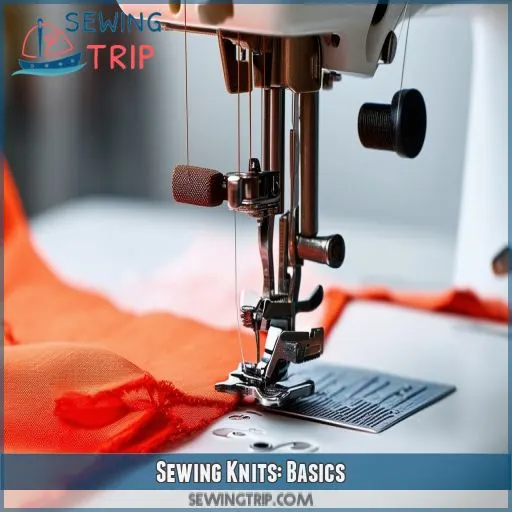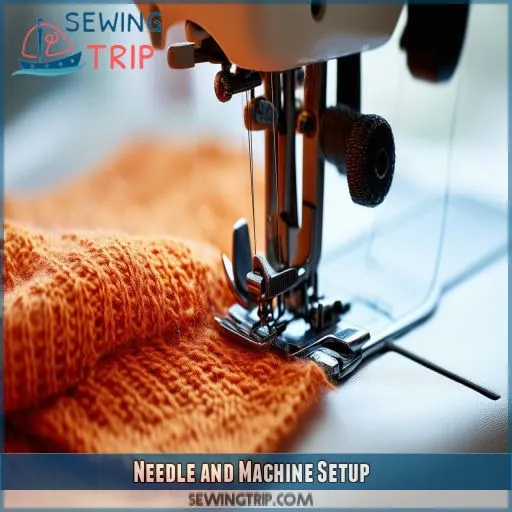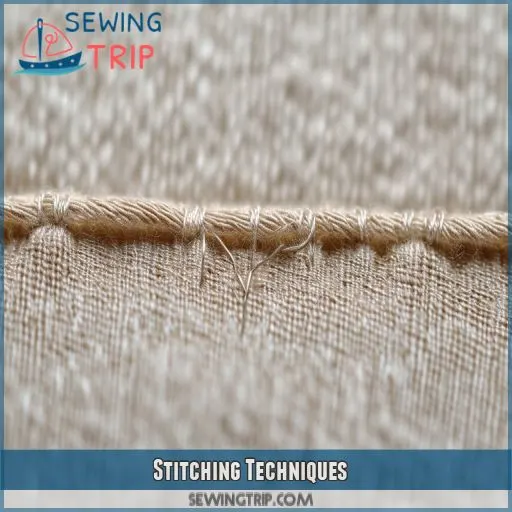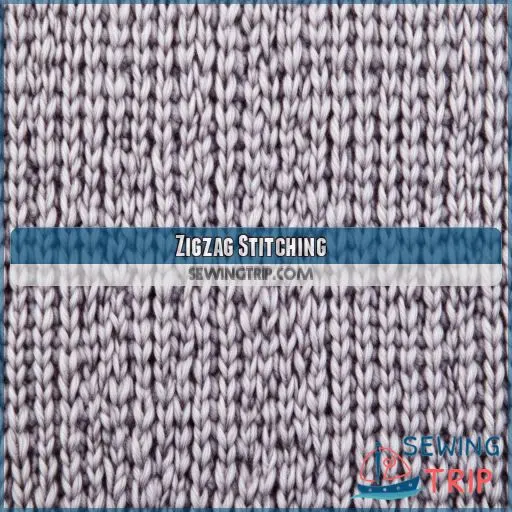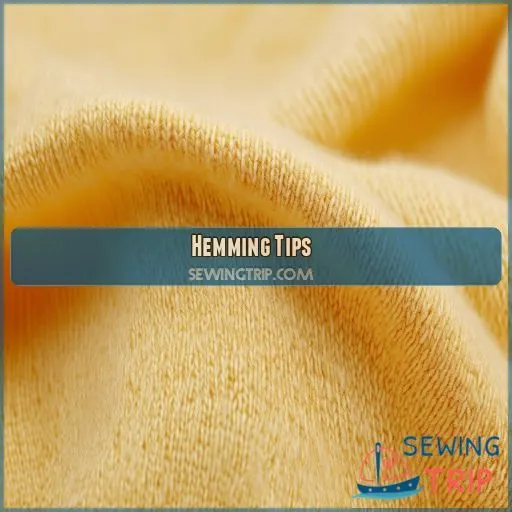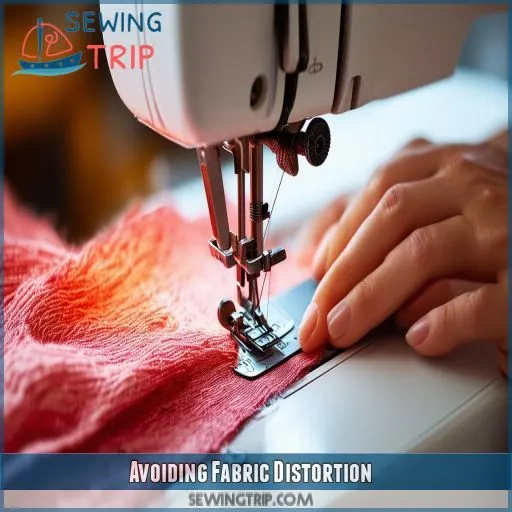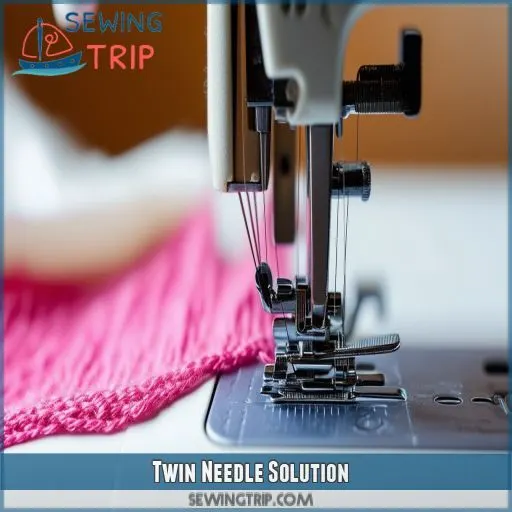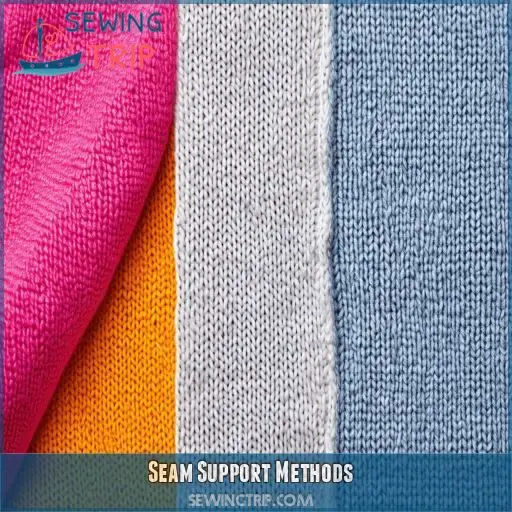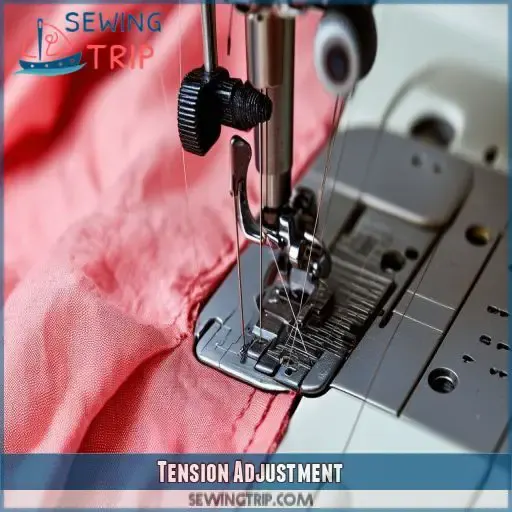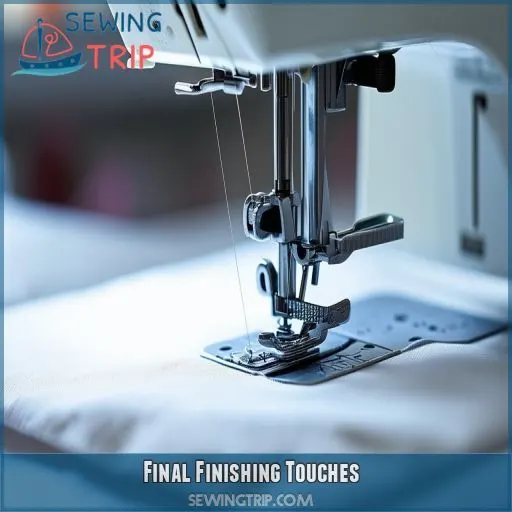This site is supported by our readers. We may earn a commission, at no cost to you, if you purchase through links.
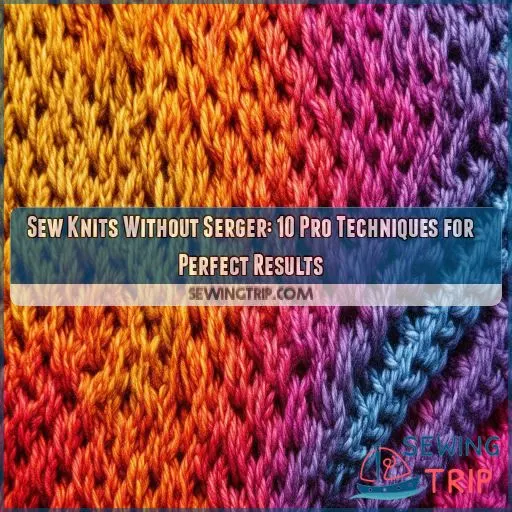
We’ll take you through every step—from choosing appropriate needles to mastering tension adjustments—and then cover some essential stitching methods and hemming tricks.
We’ll also provide useful tips to avoid distortion in your fabric from the start.
Get ready to conquer knits, expanding your sewing repertoire with confidence and precision.
Table Of Contents
Key Takeaways
- Ballpoint needles are your new BFFs – they’ll glide through knits smoother than butter on a hot pan, preventing snags and holes that’ll make you want to cry into your fabric stash.
- Zigzag stitches are the secret sauce for stretchy success. Play around with width and length until you find the sweet spot that lets your knits stretch without popping a seam (or your sanity).
- Tension is trickier than a game of Jenga with your grandma. Loosen it up a smidge to avoid puckering, but not so much your stitches look like they’ve had one too many at the sewing circle.
- Finishing touches are where the magic happens. From interfacing to steam pressing, these little details will take your knit creations from "meh" to "where’d you buy that?!" faster than you can say "homemade haute couture.
Sewing Knits: Basics
Sewing knits can be tricky, but with the right know-how, you’ll be whipping up comfy garments in no time. First things first: understand your fabric. Knits are stretchy, which means they require special handling. You’ll want to pay attention to the fabric’s characteristics, like how much it stretches and in which direction.
When cutting your pattern, keep seam allowances in mind. Knits don’t fray like woven fabrics, so you can often get away with narrower seams. As for stitching, you’ll need to adjust your machine’s settings. Play around with stitch length and width to find what works best for your fabric.
Needle and Machine Setup
Now that you have the basics, let’s get into the settings on your sewing machine to sew knits. You’ll need the correct needle and settings on your machine to even be able to work with stretchy fabrics.
First, replace your regular needle for a ballpoint or stretch needle. This baby is going to just slide through knits without snagging or creating holes.
Next up, tension adjustment on your sewing machine. Loosen it a bit to stop puckering and give it a little ease. Also, keep in mind the weight of your fabric when picking settings. Lighter knits need shorter stitch lengths; heavier ones handle longer stitches just fine.
For most knits, a zigzag or stretch stitch will be your go-to. Set your stitch length to about 2.5-3mm and width to 1-1.5mm.
Stitching Techniques
Now that you’ve got your machine set up with the right needle and tension, let’s get into some stitching techniques for knits. You’ll want to master a few of the key stitches if you’re going to get professional results without a serger. Here are five essential stitches for your knit-sewing arsenal:
*Overlock stitch: This typeset imitates the edge from a serger.
- Reinforced stitch: This strengthens the seams.
- Faux overlock: Creates a finished look
- Narrow zigzag: Mild stretch
Single fold hem: Reduces bulk
Always test your stitches first on a scrap of the fabric to achieve the right balance between stretch and stability. When sewing, use ballpoint needles to prevent snags and a stretch stitch for continued elasticity that knit garments require. And remember, pressing your hems and seams as you go makes all of the difference in creating the beautiful finish on your knit garments.
Zigzag Stitching
Now that you have the basics of stitching down, let’s get into one of the most powerful tools for sewing knits without a serger: zigzag stitching. This versatile stitch can allow your fabric to stretch without breaking threads. First, though, you’ll need to set up your machine for zigzagging. For most knits, this is usually 2-3mm in width by 2.5-3mm in length. Don’t forget to change to a ballpoint needle in a size suitable for the weight of your fabric.
As you sew, check the tension on your fabric. If you notice puckering, try reducing the pressure of your presser foot or use a Teflon sewing machine foot. Remember to not pull on the fabric as you sew; let the feed dogs do their job. If your machine doesn’t have some type of stretch stitch option available, consider a very narrow zigzag as your catch-all non-stretch stitch solution. You’ll find with practice the perfect balance of settings for each knit fabric type you encounter.
Hemming Tips
You’ve got loads of professional techniques up your sleeve when it comes to hemming knits. To provide you with the same polished finish as ready-to-wear, here are a few hem tips for your garment:
- Use single fold hems to reduce bulk and maintain stretch.
- Use a twin needle finish for a coverstitch-like appearance on your hems.
- Use a narrow zigzag to allow for slight stretch, so it doesn’t pop.
- Consider a reinforced straight stitch for firmer knits that don’t need as much give.
- Factor in garment fit when planning hem width – looser fits may need wider hems.
For drawstrings, nice casings can be made using wash-away tape to hold everything in place. In knit patterns, note hem allowances as they’re often drafted for specific techniques. Add a little decoration to your hems but keep the stretch with bias tubes.
Avoiding Fabric Distortion
Now that you’ve mastered hemming, let’s tackle a common challenge: fabric distortion. When sewing knits, your fabric can stretch out of shape faster than a chiffon scarf in a windstorm.
To keep your project looking sharp, start by adjusting your bobbin tension. A looser setting can work wonders, like magic in your dye garden. Next, focus on proper needle insertion and size. The right needle will glide through your knit like a hot knife through butter.
Adjust your stitch length and width to match your fabric’s stretch, giving it room to breathe. For delicate knits, try placing tissue paper under your fabric – it’s like creating a welt pocket for your stitches.
Twin Needle Solution
Want to achieve a professional finish on your knit projects without a serger? Enter the twin needle solution! This nifty tool creates two parallel rows of stitching on the top and a zigzag on the bottom, mimicking a coverstitch.
To master twin needle techniques, start by selecting the right needle width for your fabric. Lighter knits work well with a 2.5mm width, while thicker fabrics may require a 4mm width. Adjust your machine’s tension carefully, as twin needle fabrics can be finicky.
For best results, use a lightning bolt stitch or experiment with parabola-cut designs. Don’t shy away from twin needle patterns – they’re perfect for hems, decorative stitching, and even boutis provençal-inspired textures.
Seam Support Methods
Support your seams with needle stabilizers to prevent skipped stitches and fabric puckering while sewing knits for a professional finish.
Interfacing adds shape in many areas that just need a little structure, like around a neckline or waistband, so your garment will take form.
For a quick fix, fusible tape comes in—the magic cure for those annoying seams that want to stretch out of shape. If you’re working with very thin fabrics, use a spray adhesive to hold the pieces in place.
For support in places that are going to get a lot of wear, such as shoulders or armholes, use seam tape.
Want to add a personal flair to your seam reinforcement? Use silk blossoms, as done by none other than the now-famous designer Bonnie Cashin.
Keep in mind that supporting the seams isn’t only functional; it also affects how good it looks compared to ready-to-wear garments.
Tension Adjustment
Tension adjustment is your secret weapon for sewing knits like a pro. You’ll need to loosen your machine’s upper tension to accommodate the fabric’s stretch. Start by setting it to 3 or 4, then test on a scrap piece. Too tight? You’ll see puckering. Too loose? The stitches will gap. Adjust in small increments until you achieve a balanced stitch.
Don’t be afraid to experiment! Keep a tension log for different knit fabrics – it’ll save you time on future projects. With practice, you’ll develop a feel for perfect tension, and your knit garments will look store-bought (or even better!).
Final Finishing Touches
As you wrap up your knit sewing project, it’s time for those final finishing touches that’ll make your garment shine. Start by stabilizing any tricky areas with lightweight interfacing or stay tape.
Choose the right presser foot for topstitching – a walking foot can be a game-changer for keeping layers aligned. Don’t forget to adjust your seam allowance width; knits often benefit from a slightly narrower seam. Fine-tune your thread tension one last time, ensuring it’s balanced for a professional look.
After pressing, give your seams a blast of steam to help them relax and lie flat. Remember, patience is key here – rushing through these final steps can undo all your hard work.
Take a moment to admire your handiwork, and don’t be afraid to make small adjustments. With these pro techniques under your belt, you’ll be churning out knit masterpieces in no time!
Frequently Asked Questions (FAQs)
Can you sew knits without a serger?
Just like a skilled sailor can navigate without GPS, you can conquer knits without a serger. Use your regular machine’s zigzag or stretch stitch, ballpoint needles, and proper tension. You’ll be crafting comfy, stretchy garments in no time!
Can I sew knits with a regular sewing machine?
You can absolutely sew knits with a regular machine! Use a ballpoint needle, adjust your tension, and choose a stretch stitch. Support the fabric while sewing, and you’ll create beautiful knit garments without a serger.
Can I sew knit fabric with a straight-stitch?
You’ve likely heard it’s a no-no, but let’s test that theory. While straight-stitch isn’t ideal for knits, you can use it if you’re careful. Stretch the fabric slightly as you sew, and you’ll be surprised at the results.
Can I sew clothes without a serger?
Yes, you can sew clothes without a serger! Use your regular sewing machine with the right techniques. Try zigzag stitches, twin needles, or stretch stitches. With practice, you’ll create professional-looking garments while saving money on expensive equipment.
Can I use regular thread for sewing knits?
You can use regular thread for knits, but polyester thread is ideal. It’s stronger and more flexible than cotton. For best results, choose a thread weight that matches your fabric and adjust your machine’s tension accordingly.
How do I prevent skipped stitches on knit fabrics?
You’ve just encountered skipped stitches? Don’t worry! Use a ballpoint needle, loosen your tension slightly, and adjust stitch length. Clean your machine, change your needle if needed, and always use the right needle for knits.
Whats the best way to press knit seams?
You’ll want to press knit seams with care. Use a low heat setting and steam, gently pressing without stretching. A pressing cloth can protect delicate fabrics. Always test on a scrap first to avoid damaging your garment.
Are some knit fabrics easier to sew than others?
Yes, some knits are easier to sew than others. You’ll find stable knits like ponte or interlock simpler to work with. They’re less stretchy and don’t curl at the edges, making them more forgiving for beginners.
How do I handle very stretchy knits like spandex blends?
Holy smokes, spandex blends are slippery! You’ll want to use a walking foot, ballpoint needle, and zigzag stitch. Reduce presser foot pressure, stabilize with tissue paper, and avoid stretching while sewing. Take it slow and steady for best results.
Conclusion
Now that you’re armed with these ten professional techniques, you can sew knits without a serger like a seasoned pro.
From selecting the right needles to mastering tension adjustments, you’ve got the tools to create comfortable, versatile garments at home.

